
Marche, in English sometimes referred to as the Marches, is one of the twenty regions of Italy. The region is located in the central area of the country, and has a population of about 1.5 million people, being the thirteenth largest region in the country by number of inhabitants. The region's capital and largest city is Ancona.

Ascoli Piceno is a comune (municipality) and capital of the province of Ascoli Piceno, in the Marche region of Italy.
Gnaeus Pompeius Strabo was a Roman general and politician, who served as consul in 89 BC. He is often referred to in English as Pompey Strabo, to distinguish him from his son, the famous Pompey the Great, or from Strabo the geographer.
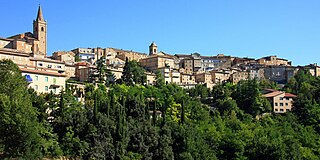
Falerone is a town and comune in the province of Fermo, in the Italian region of the Marche, southeast of Urbisaglia.

The province of Ascoli Piceno is a province in the Marche region of Italy. Its capital is the city of Ascoli Piceno, and the province is bordered by the Adriatic Sea to the east, the Province of Fermo to the north, and it faces the regions of Umbria and Abruzzo (Abruzzi) to the south. There are 33 comuni in the province, see Comunes of the Province of Ascoli Piceno.

The Province of Pesaro and Urbino is a province in the Marche region of Italy. Its capital is the city of Pesaro. It also borders the state of San Marino. The province is surrounded by San Marino and Emilia Romagna in the north, Umbria and Tuscany in the west, Ancona in the south and the Adriatic Sea on the east. The province has an enclave of the Umbrian commune of Citta' di Castello named Monte Ruperto. The province is also known as "Riviera of Hills". It is mostly covered by hills and is popular for its beaches.

The Senones or Senonii were an ancient Gallic tribe dwelling in the Seine basin, around present-day Sens, during the Iron Age and the Roman period.

Regio VI Umbria is the name for one of the 11 administrative regions into which the emperor Augustus divided Italy. The main source for the regions is the Historia Naturalis of Pliny the Elder, who informs his readers he is basing the geography of Italy on the descriptio Italiae, "division of Italy," made by Augustus. The Regio Sexta is called Umbria complexa agrumque Gallicam citra Ariminium, "Umbria including the Gallic country this side of Rimini."

Italia, also referred to as Roman Italy, was the homeland of the ancient Romans. According to Roman mythology, Italy was the ancestral home promised by Jupiter to Aeneas of Troy and his descendants, Romulus and Remus, who were the founders of Rome. Aside from the legendary accounts, Rome was an Italic city-state that changed its form of government from Kingdom to Republic and then grew within the context of a peninsula dominated by the Gauls, Ligures, Veneti, Camunni and Histri in the North, the Etruscans, Latins, Falisci, Picentes and Umbri tribes in the Centre, and the Iapygian tribes, the Oscan tribes and Greek colonies in the South.

Fermo[ˈfermo]listen (help·info) is a town and comune of the Marche, Italy, in the Province of Fermo.
The Battle of Arretium, which was probably fought in 284 BC, is a poorly documented event in the history of the Roman Republic because it occurred in a period for which some of the books of the History of Rome by Livy, the most thorough ancient historian for early Rome, have been lost. The battle is only explicitly referred to in a text by Polybius, the ancient Greek historian, which does not give much detail and puts it in the context of other events. A text by Appian talks about these events, but does not make any explicit reference to the Battle of Arretium. It was fought between the Romans and the Gauls of northern Italy, who may have been from the Senone tribe.
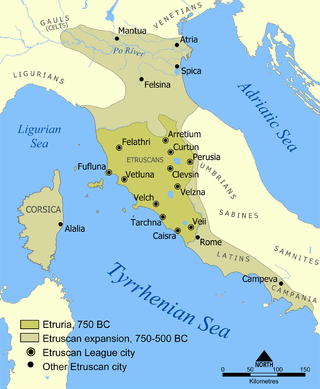
The second Battle of Lake Vadimo was fought in 283 BC between Rome and the combined forces of the Etruscans and the Gallic tribes of the Boii and the Senones. The Roman army was led by consul Publius Cornelius Dolabella. The result of the battle was a Roman victory.

South Picene is an extinct Italic language belonging to the Sabellic subfamily. It is apparently unrelated to the North Picene language, which is not understood and therefore unclassified. South Picene texts were at first relatively inscrutable even though some words were clearly Indo-European. The discovery in 1983 that two of the apparently redundant punctuation marks were in reality simplified letters led to an incremental improvement in their understanding and a first translation in 1985. Difficulties remain. It may represent a third branch of Sabellic, along with Oscan and Umbrian, or the whole Sabellic linguistic area may be best regarded as a linguistic continuum. The paucity of evidence from most of the 'minor dialects' contributes to these difficulties.

North Picene, also known as North Picenian or Northern Picene, is a supposed ancient language, which may have been spoken in part of central-eastern Italy. The evidence for the language consists of four inscriptions dating from the 1st millennium BC, three of them no more than small broken fragments. It is written in a form of the Old Italic alphabet. While its texts are easily transliterated, none of them have been translated so far. It is not possible to determine whether it is related to any other known language. Despite the use by modern scholars of a similar name, it does not appear that North Picene is closely related to South Picene, and they may not be related at all. The total number of words in the inscriptions is about 60. It is not even certain that the inscriptions are all in one language. A recent study of the techniques used on the stone and other considerations have led to the conclusion that all supposed North Picene inscriptions are in fact forgeries created in the 1800s.
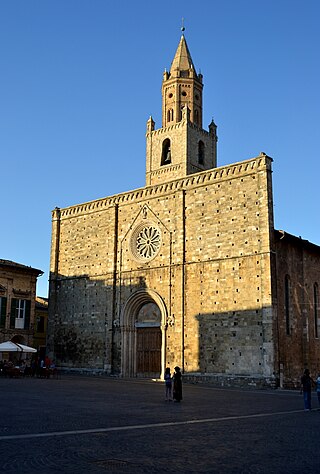
Atri is a comune in the Province of Teramo in the Abruzzo region of Italy. Atri is the setting of the poem The Bell of Atri by American writer Henry Wadsworth Longfellow. Its name is the origin of the name of the Emperor Hadrian, whose family came from the town.

Cupra Marittima is in the Province of Ascoli Piceno in the Italian region Marche, located about 70 km (43 mi) southeast of Ancona and about 30 km (19 mi) northeast of Ascoli Piceno.
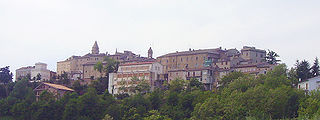
Monte Rinaldo is a comune (municipality) in the Province of Fermo in the Marche region of Italy, located about 30 km (19 mi) north of Ascoli Piceno and 25 km (16 mi) west of Fermo.
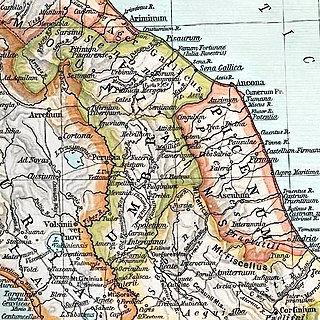
The Ager Gallicus was the territory in northern Picenum that had been occupied by the Senone Gauls and was conquered by Rome in 284 BC or 283 BC, either after the Battle of Arretium or the Battle of Lake Vadimon.

The Picentes or Piceni or Picentini were an ancient Italic people who lived from the 9th to the 3rd century BC in the area between the Foglia and Aterno rivers, bordered to the west by the Apennines and to the east by the Adriatic coast. Their territory, known as Picenum, therefore included all of today's Marche and the northern part of Abruzzo.
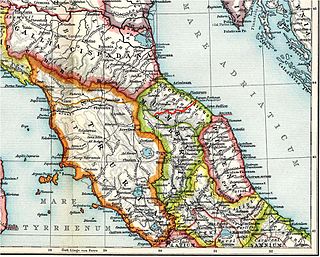
The Battle of Silva Litana was an ambush that took place in a forest 75 miles northwest of the Roman city of Ariminum during the Second Punic War in 216 BC. The Gallic Boii surprised and destroyed a Roman army of 25,000 men under the consul-elect Lucius Postumius Albinus and destroyed the Roman army, with only ten men surviving the ambush, a few prisoners were taken by the Gauls and Postumius was killed, his corpse was decapitated and his skull was covered with gold and used as a ceremonial cup by the Boii. News of this military disaster, reaching Rome probably after the election of consuls for 215 BC in Spring 215 BC or after the defeat at Cannae in the fall of 216 BC, triggered a renewed panic in Rome and forced the Romans to postpone military operations against the Gauls until the conclusion of the Second Punic War. Rome decided to focus on defeating Hannibal and sent only two legions to guard against any possible Gallic attack, however, the Boii and Insubres did not attack the Romans to exploit their victory. Cisalpine Gaul remained in relative peace until 207 BC, when Hasdrubal Barca arrived in Cisapline Gaul with his army from Spain.

















